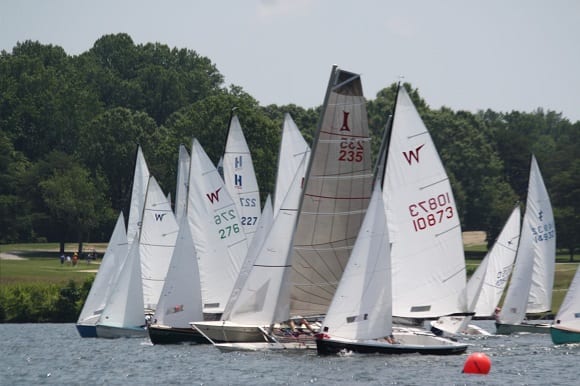Want to get more local one design sailors out racing?
An interview with Nathan Titcomb, US Sailing’s Offshore Director
US Sailing: What is the new Portsmouth Yardstick Online (PYOnline)?
Nathan Titcomb: PYOnline is the Royal Yachting Association’s updated version of the traditional Portsmouth Yardstick. It is online interface for collecting results and calculating new ratings for classes with limited data, or local club ratings. It is basically an objective calculation of data that results in real-time updating and adjustment of the ratings numbers once results have been input. US Sailing has teamed up with the RYA to bring the system to sailors in the U.S.
US Sailing: How does it work?
Nathan Titcomb: Mixed fleets of different classes race on the same course. The elapsed times are recorded (and scored using national ratings) and then uploaded into the PYOnline portal. PY online then takes the elapsed times and statistically calculates new rating suggestions based upon the results. When multiple boats of the same class are racing, only the best times are used in creating updates. The only challenge is when only one boat of a class or configuration is being sailed, some common sense needs to be applied to not provide updated ratings based upon poor sailing. The more data that is entered for multiple races, the more accurate the ratings suggestions become.

US Sailing: How does this differ from the old Portsmouth Yardstick?
Nathan Titcomb: Simply put, it’s modern! Sailors here in the U.S. have been using a 50-year-old system, until now. The more complete answer is that PYOnline ensures faster, more defensible updates to the Portsmouth numbers. It also gives an individual club or fleet the tools to make local adjustments to specific ratings based upon the statistical analysis of the results of previous races. There are other differences too. The numbers in the US DPN (Dixie Portsmouth Number) system were all based upon a constant of the Thistle Class that had a number of 83.0. The new numbers are generally larger in value by a factor of about 10 meaning the general base number is about 1,000. Plus, every time you enter results, the system adjusts the rating for a class being sailed in your local fleet.
US Sailing: What does this really mean for one design sailors/classes?
Nathan Titcomb: There are several reasons why a one design sailor/class would be interested in sailing under the PY.
- First, we have all shown up to a race night or event where there just wasn’t enough boats to have a one design start. By combining classes under PY it provides an opportunity to get on the water and compete in a slightly different way and still have fun doing what we all love, sailing.
- The second reason is that PY can help new designs/classes get on the water with competition to help finalize development or even help to grow fleets by just starting with one or two boats locally. If somebody else sees how cool your new boat is, they might want to get one too. You can only sail alone for so long before you’re ready to line up against another boat and go racing. PY can provide that opportunity.
- There is also a third possibility that may not be for everyone. Since the system is results based, you could treat an existing one design fleet as a mixed fleet with each sailor being a “class” and come up with assigned rating numbers adjusted for skill ability for each of the skippers/teams to help level the playing field. You would then have two results for a given day, the actual one design finish order and then the PY order which might help keep the team/boats at the back of the pack coming back to get better.

US Sailing: What does it take to make it happen or to get started?
Nathan Titcomb: Have your class or local club sign up at the link below (to be provided). This will get you the login credentials for uploading your results and the calculations that come from those results.
You can also start by just racing and collecting times. The PYOnline webpage has a good starting point for the PY numbers for about 1,000 classes.
The simplest way is to get a few boats and go racing. You will need a race committee volunteer to capture elapsed times and someone who can use either simple scoring software or a spreadsheet, but that’s it!
US Sailing: How many boats does it require?
Nathan Titcomb: A minimum of 3… From there, add as many as you like!
US Sailing: If I am a One Design sailor, does it track my progress or only that of my boat class?
Nathan Titcomb: While there is the potential for all sailors to be tracked across classes with the PY system, this would be in a later update to the PYOnline platform.
US Sailing: How often does it get updated?
Nathan Titcomb: At the local level, potentially after every race that results are submitted for. But, on the national level, we will be releasing yearly updates to the national ratings.
US Sailing: Can PYOnline accommodate both one design classes and PHRF style boats?
Nathan Titcomb: Yes, it can handle both, however it becomes a bit of a challenge if the PHRF boats are changing configurations like spinnaker sizes, crew, or other things on a daily basis. However, if those changes are tracked, the system should work well to mix dinghies and keelboats. Remember, many of the keelboats that are racing PHRF are also one design boats!
